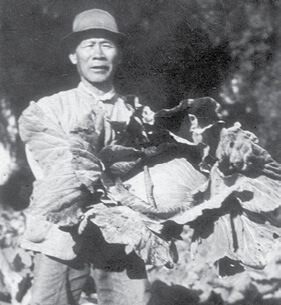The Chinese market gardeners and their kin have long since departed Wahgunyah, but their legacy, and the lands they toiled, to tender their plants on the banks of Sunday Creek, remain.
Wahgunyah’s Chinese population were an integral part of the social fabric of the region at the end of the 19th century and remarkably, they were able to straddle the racial divide that existed in so many other parts of the country at this time.
However, in 1901, the first piece of legislation Federation passed, was the Immigration Restriction Act, now more commonly known as the ‘White Australia’ policy, and many Chinese, including those prominent families in Wahgunyah, were forced to move back to China.
To understand the Chinese legacy and their journey in Australia though, one must first understand their past.
Australia has benefited enormously from the contributions made by Chinese immigrants, who began arriving in significant numbers from the 1850s, when news of the gold rush reached southern China. Prior to this, Chinese migrants had primarily been indentured, bought out by European pastoralist interests to replace convict labour.
Starting in 1853, nearly 40,000 Chinese men left home for “Xin Jin Shan”, New Gold Mountain, also known as Australia. They were not independent travellers, but large sponsored migrant groups. Many left behind impoverished conditions, and their families, hoping to discover gold to build a better life for themselves and support their families back home.
The Chinese miners often worked in organised groups of 30 to 100 men, under the direction of a leader, which resulted in their gold digging efforts being very successful. Although the Chinese miners were generally peaceful and industrious, resentment between the Chinese and Europeans on the goldfields grew; primarily because of their success, but also because of their different customs and traditions.
By the late 1850’s, Chinese miners began outnumbering the European miners by at least 3 to 1 at the diggings in Victoria and as their numbers continued to grow, sections of the European population resented and questioned the Chinese presence in the colonies, resulting in further anti-Chinese agitation and violent clashes.
In an attempt to quell this sentiment and reduce the numbers of Chinese migrants arriving into Australia, the colonies began introducing laws and policies that restricted the rights of the Chinese people. These included a £10 poll tax on Chinese migrants arriving by sea or by land (which was a huge sum and many years of wages in those days…and those who did pay the tax were left facing incredibly large debts for decades) as well as a limit of just one Chinese migrant to every 100 tons of shipping. By 1888, the tonnage limits had increased in Victoria to one Chinese migrant to every 500 tons of shipping, and in NSW the poll tax leapt to a staggering £100 per person.
The gold rush in Australia largely ended in the late 1870’s. This, along with the passing of the Anti-Chinese immigration laws saw most of the miners return to China. Those who settled in Australia turned to work in various industries and were represented in a wide variety of occupations, including store keepers, market gardeners, tobacco farmers, cooks, and carpenters. Some worked as clerks and interpreters.
In Rutherglen, employment also included working in the vineyards and cellars of the principal wineries of the time, as well working as pastoral labourers, wood cutters and charcoal burners.
James Chen Ah Kew, was one of those early Chinese pioneers who decided to stay in the district at this time. He had arrived in Victoria in the 1850s as a gold miner and went on to own a general store in Wahgunyah. He was a prominent and well respected businessman in the district and also managed a large teams of bullock wagons that were commissioned to clear land for the settlers and plant vineyards for the wineries.
In 1887, 52 year old James Chen Ah Kew arranged to have his 22 year old wife, Lum Kou Gum join him at his store in Wahgunyah. They subsequently had 6 children here, and all their children (excluding Mary, the eldest, who was required to be at home to care for her siblings) attended Wahgunyah Primary School.
In 1901, with the formation of Federation and the introduction of the White Australia Policy, all non Australian born Chinese people were forced to return to China. James Chen Ah Kew could hardly leave his children alone in Australia, so the entire family went back to his village of Hwang Chun, in the Guangdong province.
Continued discrimination at this time reduced the occupational range of those Chinese people remaining in Australia. Many European Australians avoided market gardening and this provided a niche for the Chinese in Australia with agricultural backgrounds. By the early 1900s approximately one third of all of the Chinese people in Victoria, New South Wales and Western Australia were engaged in market gardening. It was also as gardeners, that most pre-1901 Chinese were granted status as ‘domiciles’ under the 1901 Act.
The market gardens tended to be leased, as Chinese immigrants were not permitted to retain land in Australia, unless they were naturalised, and they often lived on or near the market gardens.
The gardens were worked by between five and ten men, generally from the same clan and the produce was generally sold to local Chinese store keepers with whom they had close ties.
Their cooperative ways of working meant that partners could be replaced when one of them wanted to visit or return to China, as most of the Chinese men had left families behind in their homeland.
It is also interesting to note, that whilst the Chinese were happy to take a garden for vegetables, it was very rare for them to plant fruit-trees, which might just indicate that they were very aware they could never attach themselves permanently to the soil of Australia.
Local rate records indicate the first Chinese market gardeners appeared in Wahgunyah in 1894, but it is highly likely others gardeners would have existed at the time, they just would not have been included in the books.
There were three adjoining market gardens at Sunday Creek beside present day Pfeiffer Wines. A 1901 local newspaper reports suggest there were between 30-40 men living at the market gardens near Sunday Creek. They lived in simple shacks built of timber or timber and galvanised iron, beside the gardens and to this day, we still find old aerated bottles that were been buried by them whilst they lived there.
Occupying almost 5 acres, these fertile river flats had an abundance of fresh water from Sunday Creek and produced high yields of cabbages, cauliflowers, potatoes, onions, melons, lettuce, carrots, parsnips, spinach, leeks, radishes, beans, pumpkins, peas and tomatoes.
The three gardens were separated by 120 metre long embankments acting as irrigation channels and there was a 250m long flood mitigation embankment fronting Sunday Creek.
The gardening was very labour intensive but their methods would surely be praised today for their natural and sustainable practices. The gardens were watered and fertilised often and as many crop rotations as possible were put in each year.
The Chinese market gardeners worked from dawn to dusk using hoes, shovels, rakes, harrows, ploughs and heavy wooden yokes for carrying water cans and baskets. The raised beds were built at such a width they could easily reach across for weeding or cultivation without disturbing the plants and they meticulously looked after their vegetables, ridding them of aphids for example by brushing them individually with soapsuds.
Because of their proximity to Sunday Creek the Chinese market gardens were very susceptible to flooding, particularly when the high waters of Lake Moodemere and the Murray River overflowed.
In 1909 The Argus reported flood levels reaching 23 feet (7.01metres) with considerable damage being done to the Chinese market gardens at Sunday Creek. In 1917 the Rutherglen Sun noted that the flood was a topic of great conversation with the older residents not being able to remember such prolonged flooding, reporting that the Chinese garden, situated on Sunday Creek, had been completely submerged and that an estimated 15,000+ tomato plants had been lost.
But it was not just flooding that the Chinese market gardeners needed to contend with. As in other industries where the Chinese were successful, Chinese market gardeners also faced opposition from their European counterparts. In 1900 a Market Gardeners’ Association was formed partly in opposition to Chinese competition.
Wilful damage and vandalism to their gardens was sadly also common place at the time. The Euroa Advertiser in 1900 reported, “following upon the act of vandalism committed at Nathalia last week, where by an acre of various plants, belonging to a Chinese gardener was destroyed, peculiar significance attaches to the fact that that a similar act was committed at Wahgunyah on Saturday night or Sunday morning. Kow Lee, a Chinese gardener, living at Wahgunyah found on Sunday morning that 1600 tomato plants in full bearing had been wilfully destroyed, the total value being 300 pounds.”
There was also a rich and complex interaction between the Chinese and Australia’s First Nations people, whose shared experiences included government regulation which restricted both cultures personal freedoms.
Renowned First Nations artist Tommy McRae, who lived at Lake Moodemere, beside the Chinese market gardeners of Sunday Creek, captured their shared experiences in sketches he did at the time. His drawings show the Chinese market gardeners with their shoulder yokes and baskets and their conical hats, co-existing as each goes about their day to day lives.
The Chinese market gardeners of Sunday Creek have long since departed, but their legacy, and those of their forebears remain. Like their First Nations neighbours at Lake Moodemere, the Chinese who came to Australia during this period were largely oppressed by European settlers and this is a mostly forgotten and little discussed period in our history. Yet the Chinese contributions to our towns, our economies, our industries and our communities in those early waves of immigration to Australia are lasting legacies of the modern multiculturalism that we cherish and value today.
Surely these stories of persevering despite adversity and discrimination are worthy of a greater narrative.

The family of prominent Wahgunyah businessman Chen Ah Kew 1901 Picture Wahgunyah History Group

Picture State Library NSW

A Border Morning Mail article dated 14 August 1945 – Wahgunyah’s Promient Chinese


Tommy McCrae Illustration – Copyright National Library Australia

Tommy McCrae Illustration – Copyright National Gallery of Victoria



